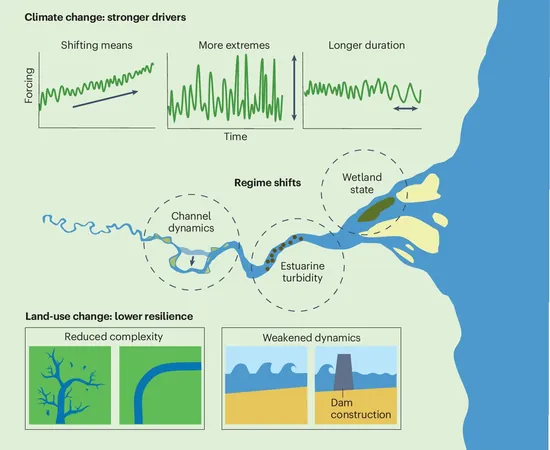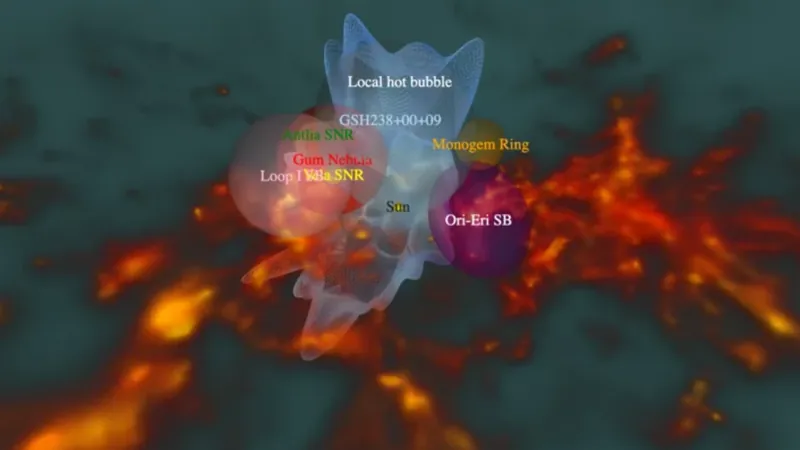
Researchers Spotlight Critical Tipping Points in River Deltas to Mitigate Flood Risks
2024-11-14
Author: Noah
As climate change continues to wreak havoc across the globe, researchers from Wageningen University & Research are sounding the alarm about the increased vulnerability of river systems. The dual threat of rising sea levels and extreme weather events is pushing rivers to a precarious state, sometimes leading to sudden, irreversible changes, including course alterations that could have catastrophic consequences.
One major culprit behind these dramatic shifts is the phenomenon known as a “tipping point,” which occurs under extreme conditions—like unprecedented water levels or flows—that force rivers into uncharted territory. “Understanding river dynamics is not just academic; it’s essential for protecting communities living alongside these waterways as our climate continues to evolve,” warns the team.
The frequency of heavy rainfall coupled with storms is amplifying these risks, particularly in regions where human interventions, such as dams and modified channels, have reshaped the landscape. “Dams disrupt the natural flow of sand and silt, essential for maintaining healthy delta ecosystems,” explains delta expert Ton Hoitink. “When sediment supply is cut off, deltas begin to sink, creating low-lying areas that resemble bathtubs—a precarious position given the rising water levels outside.”
The Right Conditions for Disaster
When severe weather, heavy rainfall, and landscape alterations converge in vulnerable regions, the results can be devastating. Such scenarios exemplify tipping points, wherein the entire river ecosystem can shift, potentially leading to long-lasting ecological harm.
A groundbreaking study published in *Nature Reviews Earth & Environment* delves into these tipping points, identifying critical processes and factors that precede such moments of change. This research is crucial for developing strategies to manage river behaviors and effectively navigate the complexities of a changing climate.
“The study examines not just how deep erosion pits form, but also other tipping phenomena,” shares lead author Roeland van de Vijsel, a physical oceanographer. “We’re looking at river course changes, accelerated sediment turbidity, and even the drowning of salt marshes—a direct result of land subsidence and eroding banks.”
Global Implications for Delta Management
The research team has crafted a comprehensive global map detailing delta vulnerabilities. This meticulous work reveals how much sediment has been obstructed by human activity over the past three decades and highlights the correlation between increasing storm intensity and sea-level rise. “For instance, the Rhine-Meuse delta has experienced a 70% reduction in sediment delivery due to dam construction, simultaneously facing rising sea levels and land subsidence,” Van de Vijsel noted. “Recognizing these risks in advance is crucial for preventing future catastrophes.”
Embracing Natural Solutions
Despite the gloom, there’s a glimmer of hope: restoring natural processes can reverse some of the negative trends. “We must have a clear vision and the courage to make tough decisions,” emphasizes Hoitink. This could involve repurposing agricultural land to allow for natural sediment flow from the sea or shifting agricultural practices to more sustainable alternatives like aquaculture.
“Inspired discourse surrounding the Netherlands in 2120 can serve as a blueprint for healthier, safer river systems,” Hoitink adds. “Sometimes, it just takes a little push to restore natural systems to their former glory. Our insights into the dynamics of tipping points will enable us to strategically steer deltas back in a favorable direction, a concept we refer to as ‘back tipping.’”
The conversation around tipping points is gaining traction in climate science circles, with international collaborations reinforcing its importance. In 2023, over 200 researchers released the Global Tipping Points Report, presenting an in-depth analysis of the tipping points affecting global systems. These include critical changes like polar ice melt, loss of tropical forests, and ocean acidification.
Despite the serious implications of these tipping points, both positive and negative, their unpredictable nature complicates forecasting. “It’s like anticipating a burnout; you can see the signs, but the trigger moment is often elusive,” Hoitink concludes. Recognizing and preparing for these tipping points is vital if we hope to secure the ecosystems and communities dependent on river deltas in an era of climate uncertainty.









 Brasil (PT)
Brasil (PT)
 Canada (EN)
Canada (EN)
 Chile (ES)
Chile (ES)
 España (ES)
España (ES)
 France (FR)
France (FR)
 Hong Kong (EN)
Hong Kong (EN)
 Italia (IT)
Italia (IT)
 日本 (JA)
日本 (JA)
 Magyarország (HU)
Magyarország (HU)
 Norge (NO)
Norge (NO)
 Polska (PL)
Polska (PL)
 Schweiz (DE)
Schweiz (DE)
 Singapore (EN)
Singapore (EN)
 Sverige (SV)
Sverige (SV)
 Suomi (FI)
Suomi (FI)
 Türkiye (TR)
Türkiye (TR)